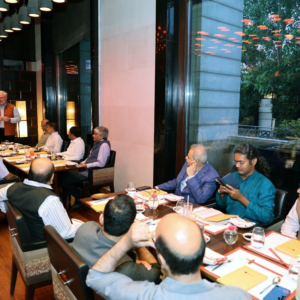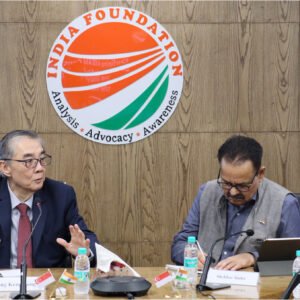Different methodologies aside, which only result in minor variations, it would be correct to state that a pie chart representing the Indian economy would be a highly disproportional one vis-à-vis the three main sectors of the economy and the number of people dependent on them. The agricultural sector for instance, is a space that employs more than 50 percent of the total workforce but contributes only 17-18 percent to the country’s GDP. On the other hand, the service sector accounts for nearly 53-54 percent of the country’s GDP that has only about 30 percent of the workforce employed in it.[1] This mismatch, notwithstanding a mostly stagnant manufacturing sector in spite of many a policy push, creates an urgent need for encouraging new businesses, entrepreneurs and skilling (re-skilling where applicable) the predominantly rural workforce of India. Another important factor one needs to take into account to fully understand the social ramifications this disproportional structure of the Indian economy causes, is the fact that during all the years post the economic reforms of 1991, India has been the fastest growing major economy in the world. Thus, in practice, this has resulted in an ever-growing gap between farm incomes and incomes derived from the tertiary sector. This elevated growth is abetting a large-scale migration of workers from farms to factories. The shift from agriculture-based jobs to jobs in the service industry requires a certain formal acquisition of knowledge and quality tertiary education is still a dream for many due to the low penetration of higher education among the majority of the population.
To approach the issue of highlighting the importance of entrepreneurship and skill development in this context, one has to also look at the technological transitions in place today. Machine learning, artificial intelligence and cost efficient robotics are rendering many current jobs/roles redundant. As the division of labour between humans and machines finds a new equilibrium, scaling up skill sets of over 300 million workers and training 100 million new hands to keep up with technological transitions is a mammoth task. This is only possible through re-skilling the workforce and incentivising individuals to look for new avenues beyond the ambit of current traditional businesses and job offerings. Relevant technical and vocational skills need to be imparted and public-private partnerships need to be fostered to achieve this task.
Perhaps the one area where India can outpace other nations in this ‘New Industrial Revolution’ is by building on its competitive edge of an upcoming massive demographic dividend with the majority of the workforce being under the age of 30 with the average age of the country expected to be 29 by the year 2026[2]. This, coupled with the fact that India will soon be the most populous country in the world, makes for an interesting dynamic. Even today, India has one of the largest workforces in the world. The best case for India is therefore to spruce up its comparative advantage and churn out a smart, skilled workforce which is in sync with the requirements of a new global economic order. Traditional knowledge needs to be monetised and inherent acquired strengths need to be leveraged by investments in a knowledge based economy leading to sustained smart skill sets. In the last five years, numerous pro-business reforms and prudent policy steps have been taken in this direction by the government and India Inc.
For the sake of simplicity, we shall only take examples and ramifications of a few initiatives, namely, Startup India, Standup India and Skill India. These campaigns, initiated by the Government of India in partnership with institutional stakeholders and private players, aim to prepare and encourage young Indians to look for employment in avenues previously considered ‘safe’ only for the 1 percent. With an initial pool of 100 billion rupees and an additional pledge of USD 10 billion by Japanese firm SoftBank, Startup India is incubating startups in the country by offering various incentives like fewer inspections, tax sops for the first 3 years, easy 90 day exit window and under Standup India enabling women entrepreneurs and entrepreneurs from the backward classes distinct benefits in uplifting themselves and also promoting India as a start-up hub across the world. As collaterals, patent fees have been slashed and innovation is being encouraged under the overall aegis of the Atal Innovation Mission. Skill India, on the other hand, aims to train over 400 million people in India in different skills by 2022. Many initiatives of the government have been clubbed under the Skill India Mission with partnerships from all spheres. The United Kingdom too has entered into a partnership with India under this scheme and virtual partnerships will be initiated at the school level to enable young people to experience the school system of another country and also develop an understanding of the culture, traditions and social and family systems. In the annual budget of 2017-18, 170 billion rupees were allocated to the Skill India Mission. The first of its kind, public-private-partnership company, The National Skill Development Corporation India was also created with the mandate of catalysing the skill development landscape in India.
As a result, India has moved up to number 77 in the Ease of Doing Business Index, a major improvement in rankings in recent times and bettered its ranking in the Global Innovation Index by moving up five places to number 57 in a list of 126 nations. Clubbed with various other initiatives and schemes, and a rich pool of English speaking engineers, doctors, researchers, businesses and scientists, global optimism in the Indian economy has been re-enforced and investor confidence improved. Broadening the bandwidth of these knowledge factories and the structural strengthening of India’s economy to the benefit of small and medium sized enterprises, that are not only job creating centres but also drivers of economic growth, is the need of the hour. Furthermore, partnerships in this area with other strategic partners like the ASEAN countries needs to be pursued, for together India and ASEAN make up about 30 percent of the world’s population and have a combined GDP might of around USD 5 trillion.
Bibliography
Economic Survey 2017-18, Government of India, Ministry of Finance, Department of Economic Affairs, January 2018.
IMF Working Paper: The Demographic Dividend: Evidence from the Indian States; Shekhar Aiyar and Ashoka Mody; International Monetary Fund; February 2011.



